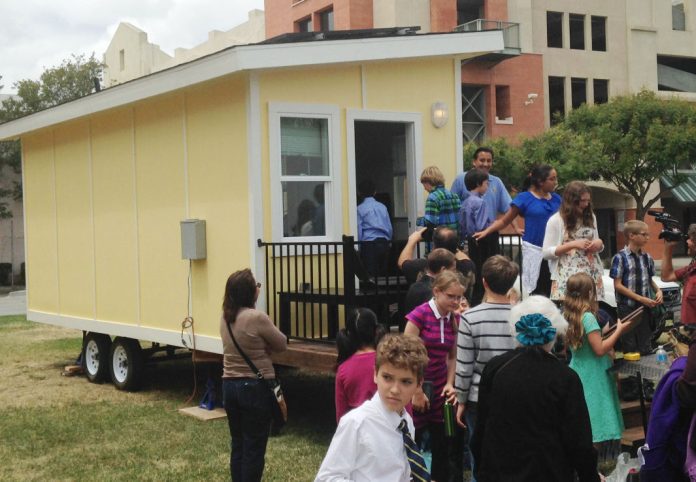
Mayor Ignacio Velazquez’s cheery, butter-yellow house sitting on the lawn by the Brigg’s Building looked too small to have much in it. But inside, a shower, a bedroom, a toilet and a bench filled a space smaller than most living rooms.
This “tiny home” with all electric power and solar panels is Velazquez’s solution to homelessness in San Benito County. The Hollister official is imagining a village of the homes and he’s partnering with school children at the Hollister Dual Language Academy and the Sunnyvale-based Helios School to dream up what they might look like.
Youth from the schools conducted surveys in their local communities about perceptions of homelessness and made blueprints of possible houses, then shared their findings at the End Homelessness Tiny Homes Summit in downtown Hollister this week.
“We designed one for a more spiritually orientated person,” said Maya Ridenour, 11, a sixth grader at Helios, as she looked at her poster. “We designed it very minimalistically … We got rid of a lot of things you’d think are a necessity but aren’t.”
The design Ridenour describes is simple partly due to space constraints since the tiny home she planned with a classmate had to be just 8 feet by 20 feet, or 160 square feet.
Sarah Mulzet, 11, a fifth grader at Helios, designed a “crafting kingdom” house, complete with a kiln for firing ceramics and storage space for creative bits and pieces, within the same size parameters.
“It was designed for artists but it could be for any personality type,” she said.
The mayor has papers in progress to start the nonprofit, New Horizons, which will specialize in creating a community of these tiny homes in San Benito County, he told the Free Lance on Thursday afternoon. The homes, including the one built by the mayor, aren’t cheap. Each costs $20,000 to $25,000, he said. Those selected to live in the residences will pay an income-adjusted rent, volunteer in the community and keep jobs, Velazquez said.
The mayor thought about adding Wi-Fi to the homes, but decided against it.
“The idea is basic but comfortable,” he said. “We want them to come home and be comfortable but strive for something more.”
Having the students look at the issue of homelessness has provided a fresh look at an age-old topic.
“With the kids, you get a different view of what’s going on,” Velazquez said. “When you see it through a kid’s eyes, you let down your guard and open up a little bit.”
At Helios, fifth and sixth grade students studied nomadic cultures in the fall, then shifted to looking at homelessness this spring. Originally, the partnership was just between the mayor and Helios but then the school asked to partner with a local campus and the city official suggested the Hollister Dual Language Academy.
Sixth grader Isaiah Ramirez, 11, was one of a select group of high-achieving academy students who helped survey community members about homelessness by asking questions in Spanish and English. The youth will work on blueprints for tiny-home designs next year and might even help with construction next summer, according to students.
The sixth grader was surprised by the depth of some answers and the “negativeness” of others.
“A lot of people said, ‘Well that’s their problem,’” Ramirez said. “Also, one of the negative responses was, ‘I don’t care about them.’”
His small group gave up vacation time to conduct their surveys on a Saturday during spring break.
“It was sad to see how people don’t really see how we’re all the same,” said the sixth grader. “We’re all human.”
While the form of the tiny homes is beginning to take shape, the timeline for actually building them isn’t clear yet.
“The problem is really location,” Velazquez said.
The mayor plans to leave government funding out of the project and won’t be pursuing grants, which come with their own sets of restrictions, he said. Instead, Velazquez plans to use private donations and support from nonprofits to build a community where low-income workers and the homeless can get a fresh start by living side by side in a mixed community.
“This is more for the person that’s made a commitment to change their lives,” he said.
For now, the cheery, yellow house is going to be parked somewhere locally for a trial run, the mayor said.
“We’ll test it out, see what we can improve on and build the next one,” he said.








